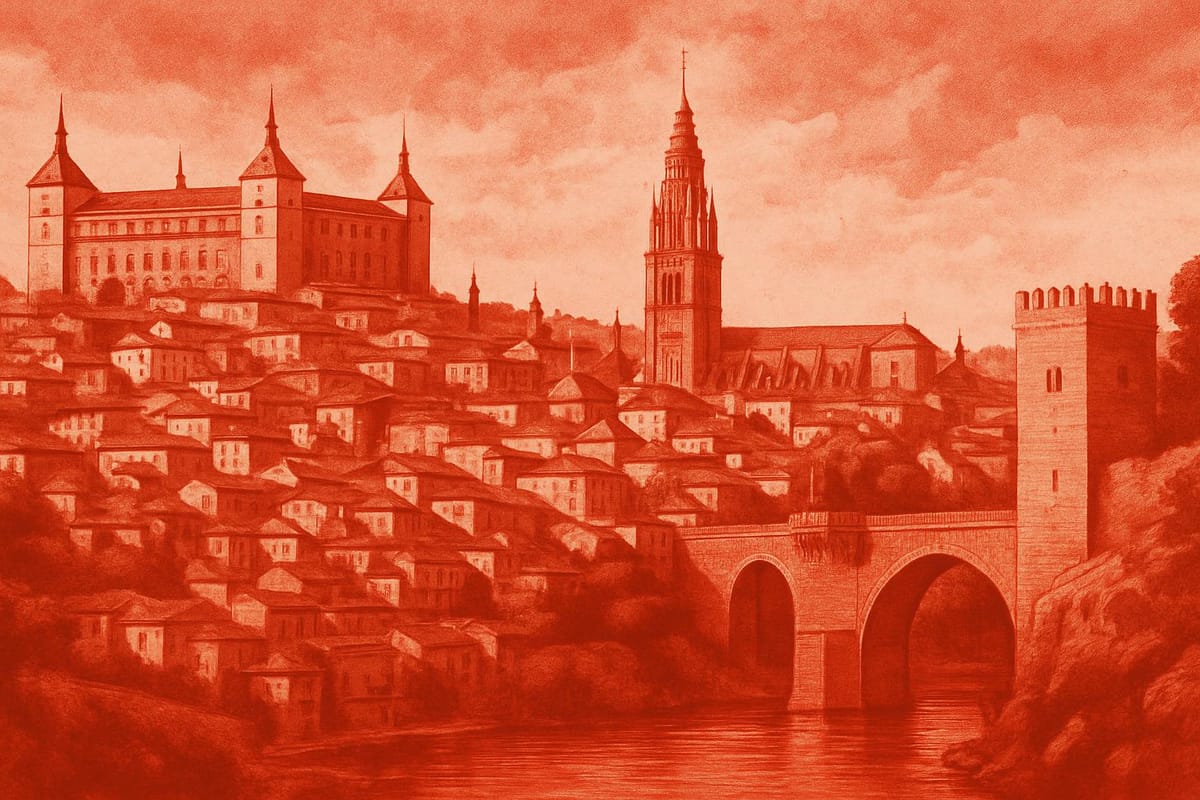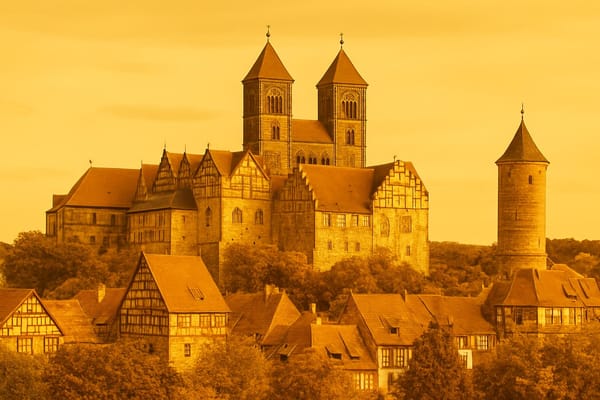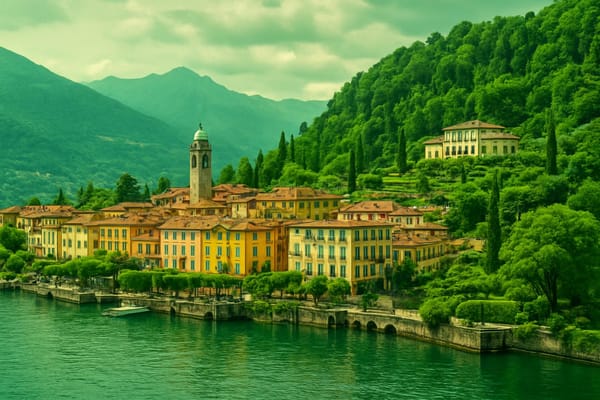Toledo
Medieval hilltop charm: Alcázar fortress, grand cathedral, El Greco art & river views

Important things to know about Toledo
Toledo, Spain is a city where history is woven into the very fabric of daily life, a compact and atmospheric capital of Castile-La Mancha that balances solemn tradition with living culture; winding cobbled streets, layered neighborhoods and the slow loop of the Tagus River create a sense of place that feels both intimate and monumental, reflecting centuries of Roman, Visigothic, Islamic, Jewish and Christian influences that shaped its language, cuisine and crafts. The urban silhouette rises from the plain in tones of warm stone, and the interplay of light and shadow on facades, plazas and narrow passageways invites a slow, sensory appreciation of texture and scale rather than a checklist of monuments; artisans still practice Damascene metalwork and traditional swordsmithing techniques, local markets and taverns offer regional flavors rooted in Manchego cheese, stews and olive oil, and the rhythm of festivals, university life and small businesses keeps the city contemporary. Cultural life in Toledo moves between preservation and innovation: museums, workshops and academic institutions conserve manuscripts and craftsmanship while galleries, music and contemporary culinary scenes reinterpret old forms. For writers, historians and travelers seeking authentic Spanish urban character, Toledo offers a concentrated experience of layered time and human creativity, where every street corner and historic building suggests stories of trade, coexistence and resilience, and the whole city reads like a living archive that rewards curiosity and slow attention.
Sightseeing hot-spots in Toledo
Toledo, Spain is a compact jewel of history where every winding street invites discovery. The historic center perches above the Tagus River, offering dramatic views and an easy walk between landmarks. Sightseeing in Toledo often begins at the Cathedral of Toledo, a masterpiece of Gothic art whose interior is filled with altarpieces, chapels, and paintings by El Greco and other masters. Nearby, the imposing Alcázar of Toledo dominates the skyline; once a Roman palace and later a military academy, the Alcázar now houses exhibitions that reveal the city’s layered past. Strolling through the city, visitors will notice the mix of Christian, Muslim, and Jewish influences that make Toledo a vivid example of Spain’s multicultural history.
The Jewish Quarter remains one of the most evocative areas for sightseeing in Toledo, with narrow lanes, historic synagogues, and small museums that tell the story of the medieval Jewish community. The Monastery of San Juan de los Reyes is another must-see, its ornate cloister and carved stonework reflecting the power of the Catholic Monarchs. Art lovers will want to follow in the footsteps of El Greco, whose dramatic canvases are displayed across the city and provide insight into Toledo’s spiritual intensity. For those interested in panoramic photography or sunset views, the banks of the Tagus River and the various miradors (viewpoints) provide picture-perfect compositions of rooftops, towers, and bridges.
Practical sightseeing tips in Toledo include allowing time to wander without a strict itinerary: part of the city’s charm is discovering hidden plazas and artisan shops that sell damascene metalwork and marzipan treats. The main square, Plaza de Zocodover, remains a lively hub where locals and visitors converge, making it a convenient starting point for guided tours or independent exploration. Whether you are searching for cultural landmarks, historic architecture, or atmospheric streetscapes, Toledo, Spain delivers a rich, walkable experience that consistently ranks among the top destinations for travelers seeking authentic Spanish history and art.
Hotels to enjoy in Toledo
Toledo is a city where every street feels like a step back in time, and the hotels in Toledo reflect that unique blend of historic charm and modern comfort. Many properties are housed in renovated palaces and convents within the old town, offering guests the chance to wake up within sight of the Toledo Cathedral or the imposing Alcázar. Staying near the winding lanes gives visitors easy walking access to museums and tapas bars, while hotels perched above the river Tagus provide panoramic views that are especially beautiful at sunset. For travelers seeking a more intimate stay, boutique hotels emphasize local architecture and artisanal touches, whereas larger establishments offer concierge services and on-site dining for a more traditional, full-service experience.
Choosing among the wide range of accommodation in Toledo, Spain can be a rewarding part of the trip, whether you prioritize luxury amenities, a budget-friendly rate, or a family-friendly layout with connecting rooms. Many hotels advertise breakfast with regional flavors and rooftop terrace spaces that become natural gathering points after a day exploring the UNESCO-listed center. A central location puts the city’s historic sights within easy reach and reduces time spent commuting, which is useful for short city breaks. For the best value and availability, consider booking early, compare properties that highlight local experiences, and look for rooms that promise views or quiet courtyards-small details that often define memorable stays in Toledo.
Restaurants to try in Toledo
Toledo, Spain offers a rich tapestry of flavors where historic streets and culinary tradition meet. Strolling through the Jewish Quarter and past the silhouette of the Alcázar, visitors discover a wide range of Toledo restaurants from cozy tapas bars to refined dining rooms that celebrate Castilla-La Mancha produce. The city's gastronomy is anchored by ingredients like Manchego cheese, saffron, and robust olive oil, and classic local dishes such as carcamusas and slow-simmered stews appear alongside creative tasting menus. Many eateries offer terraces with sweeping views of the river Tagus, making dinner a sensory experience that blends panoramic vistas with the aromas of grilled meats, seasonal vegetables, and freshly baked mazapán desserts that recall Toledo’s centuries-old confectionery tradition.
Finding the right table in Toledo rewards travelers who want authentic flavors and memorable service; a tapas crawl in the historic center reveals small plates and family-run kitchens where recipes have been passed down for generations. Wine lovers will note careful pairings featuring wines from La Mancha, and menus often highlight local suppliers and market-fresh fish or game when in season. Practical dining tips-like reserving ahead for popular spots, trying the menu del día for midday value, and exploring both hidden taverns and modern restaurants-help visitors fully enjoy the culinary scene. Whether you seek traditional recipes or inventive contemporary cuisine, the restaurants of Toledo, Spain deliver a delicious bridge between past and present.
Best shopping stops in Toledo
Toledo is a treasure for shopping in Spain, and Toledo shopping blends history and craftsmanship in every narrow street. Wander from the bustling Plaza de Zocodover into the atmospheric Jewish Quarter, where small boutiques and centuries-old workshops sell signature Damascene jewelry, polished Toledo steel swords and espadas hand-forged by skilled artisans. Shoppers will also find delicate ceramics, traditional leather goods, and locally made marzipan-all perfect souvenirs that reflect the city’s multicultural past. Many stores display reproductions of El Greco paintings and small décor pieces influenced by the nearby Toledo Cathedral and the imposing Alcázar, making it easy to combine cultural sightseeing with high-quality retail finds while exploring the old town’s winding lanes.
For a successful day of shopping in Toledo Spain, visit independent galleries and artisan studios where owners often explain the techniques behind damascening and blade polishing, creating a meaningful connection to each purchase. The city’s compact center encourages leisurely discovery, from modern boutiques to family-run shops offering custom engravings and handmade gifts. Seasonal markets and occasional artisan fairs add variety, while tourist services support tax-free shopping and multilingual assistance. Whether hunting for a unique gift or experiencing traditional crafts firsthand, Toledo offers a memorable shopping experience that marries authentic local products with the historic ambiance of one of Spain’s most picturesque cities.
Nightlife highlights in Toledo
Toledo, Spain comes alive after dusk with a magical blend of history and modern fun, making Toledo nightlife an unforgettable experience. Wander through the cobblestone streets of the historic center and discover intimate tapas bars tucked beneath ancient stone, where locals savor regional wines and share plates of manchego and jamón. The plazas around the Alcázar and the Cathedral glow with terrace lights, perfect for sipping cocktails while watching the world go by. For a taste of tradition, small flamenco venues and taverns offer passionate performances that capture the soul of the city, while cozy wine bars present curated selections of local Denominación de Origen labels.
As the night deepens, the energy shifts toward lively pubs and low-key clubs where DJs spin everything from modern hits to indie tracks, catering to both visitors and university crowds. Live music venues regularly host jazz, rock, and acoustic sets, creating an eclectic soundtrack to your evening. Street-side vermuterías and late-night pastry shops provide a delicious end to the night, and the vistas over the Tagus River under starlight make Toledo’s nocturnal charm impossible to resist. Whether you prefer elegant cocktail lounges, rustic taverns, or spirited bars, nightlife in Toledo invites you to explore, taste, and linger.
Getting around in Toledo
Toledo does not have a commercial airport, so travelers typically fly into Madrid-Barajas Adolfo Suárez (about 70 km north) and continue by road or rail to reach the city; from Madrid you can pick a direct RENFE high-speed connection or intercity bus services, drive in roughly an hour, or take a taxi, making Madrid the main international gateway for Toledo travel. The Toledo train station is well connected to Madrid Puerta de Atocha by high-speed AVE/Avant services that cover the distance in around 30–35 minutes, which is often the fastest and most convenient option for visitors wanting to combine speed with easy access to the UNESCO-listed historic center; the station sits a short bus or taxi ride from the old town and regional buses and commuter lines provide further links across Castilla‑La Mancha. For SEO-minded travelers searching for “how to get to Toledo from Madrid” or “Toledo airport to city center,” the clear advice is to use Madrid-Barajas for flights and RENFE’s high-speed trains for the quickest onward journey, while allowing extra time for local transfers, luggage, and peak-season demand.
Culture must-see's in Toledo
Toledo, Spain unfolds like a living history book where Roman, Visigothic, Islamic, Jewish and Christian layers meet in narrow streets and panoramic viewpoints. The compact old town, crowned a UNESCO World Heritage site, centers on the monumental Toledo Cathedral and the fortress-like Alcázar, while the legacy of El Greco gives the city an unmistakable artistic aura found in galleries and the El Greco Museum. Wandering through the Jewish Quarter, visitors encounter the austere beauty of the Synagogue of Santa María la Blanca and the Synagogue of El Tránsito, echoes of a plural past that also speaks through elegant Mudejar architecture. Perched above the Tagus River, Toledo’s viewpoints reward travelers with photo-ready vistas of terracotta roofs and church spires that reinforce its reputation as one of Spain’s most evocative cultural destinations.
Beyond monuments, Toledo’s cultural highlights extend into living traditions of craftsmanship and festive life. The city is famous for swords and Damascene metalwork-intricately inlaid steel and gold pieces that illustrate centuries of artisanal skill-alongside sweet local specialties such as marzipan that reflect culinary history. Year-round, lively museums and cultural centers host exhibitions that deepen appreciation for Spanish and Sephardic heritage, while annual events like Semana Santa and Corpus Christi transform the streets into theatrical processions of pageantry and devotion. Whether exploring galleries, sampling regional gastronomy, or shopping for handmade gifts, visitors to Toledo, Spain discover a compact cultural capital where history, art and living tradition create an unforgettable urban tapestry.
History of Toledo
Toledo, Spain boasts a layered and dramatic past that has shaped its identity as a crossroads of cultures and a magnet for visitors interested in the history of Toledo. Founded on a strategic hill above the Tagus River, the city grew from Roman foundations into the Visigothic capital in the early medieval period, leaving a legacy of early Christian art and law. After the Islamic conquest in the 8th century, Toledo became a thriving Islamic taifa where architecture, science, and trade flourished; the city’s Jewish quarter and the coexistence of Christians, Muslims, and Jews fostered a vibrant intellectual climate often referred to as convivencia. The Reconquista in 1085, led by Alfonso VI, transformed Toledo into a major center of Christian power in Castile, where the construction of the spectacular Toledo Cathedral and the adaptation of Mudejar styles created a unique architectural tapestry. Over centuries Toledo’s artisans refined metalwork and swordsmithing, while medieval schools of translation in the city helped transmit Arabic and Hebrew knowledge into Latin, cementing Toledo’s reputation as a bridge between worlds.
By the Renaissance and into the modern era, Toledo gained further renown as the home of the painter El Greco, whose dramatic canvases captured the spiritual intensity of the city’s streets and churches, and as the fortified site of the imposing Alcázar, which witnessed sieges and strategic episodes through the Napoleonic wars and the Spanish Civil War. The arrival of the Spanish Inquisition and political shifts, including the transfer of the royal court to Madrid in the 16th century, altered Toledo’s political status but did not diminish its cultural influence. Today, the historic center of Toledo, Spain is recognized as a UNESCO World Heritage Site, drawing travelers to its labyrinthine lanes, synagogues such as Santa María la Blanca and El Tránsito, and panoramic views over the meandering Tagus River. The continuous preservation of monuments, museums, and traditional crafts keeps the history of Toledo alive, making it an essential destination for those seeking Spanish history, medieval architecture, and a vivid example of cultural synthesis.



